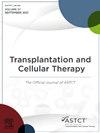Outcome of Patients With IDH-Mutated AML Following Allogeneic Stem Cell Transplantation—A Retrospective Analysis on Behalf of the German Registry for Hematopoietic Stem Cell Transplantation and Cell Therapy, DRST
IF 3.6
3区 医学
Q2 HEMATOLOGY
引用次数: 0
Abstract
Mutations in isocitrate dehydrogenase 1 and 2 genes (IDH1 and IDH2) are found in 15% to 20% of patients with acute myeloid leukemia (AML). IDH inhibitors have been introduced as targeted treatment and are currently under investigation as maintenance therapy after allogeneic transplantation (allo-SCT). Since reports about the outcome of IDH1- and IDH2-mutated (IDHmut) AML after allo-SCT are limited, we retrospectively analyzed 356 IDH-mutated AML patients (IDH1 40%, IDH2 60%). Ten patients (4%) had received an IDH inhibitor prior transplantation, but none had received maintenance with IDH inhibitors. After a median follow-up of 24 months 3-year probabilities of overall (OS) and event-free (EFS) survival, relapse and nonrelapse mortality (NRM) for the entire cohort were 73%, 60%, 27% and 13% respectively. While 3-year OS (78% versus 70%), EFS (56% versus 63%) and NRM (10% versus 14%) rates were similar for IDH1mut and IDH2mut patients, relapse incidence was numerically higher in IDH1mut patients (34% versus 24%) and landmark analysis suggested a continuous rise of relapse incidence preferentially in IDH1mut AML also beyond the first year. Concordantly, IDH2 mutation was associated with superior EFS and by trend with lower relapse incidence. The strongest risk factor for adverse outcomes, however, was AML not in CR. This analysis provides benchmarks for interpretation of results emerging from post-transplant maintenance trials in IDHmut AML and suggest that maintenance strategies may further optimize the promising outcome in this molecularly defined subgroup by reducing relapse risk, especially for patients whose AML is not in remission at time of alloHCT.

异基因干细胞移植后idh突变AML患者的预后——代表德国造血干细胞移植和细胞治疗登记处(DRST)的回顾性分析。
异柠檬酸脱氢酶1和2基因(IDH1和IDH2)突变在15%至20%的急性髓性白血病(AML)患者中发现。IDH抑制剂已作为靶向治疗引入,目前正在研究作为同种异体移植(alloo - sct)后的维持治疗。由于关于IDH1-和IDH2突变(IDHmut) AML在同种异体sct后预后的报道有限,我们回顾性分析了356例idh突变的AML患者(IDH1 40%, IDH2 60%)。10名患者(4%)在移植前接受了IDH抑制剂,但没有人接受IDH抑制剂维持。中位随访24个月后,整个队列的3年总生存率(OS)和无事件生存率(EFS)、复发和非复发死亡率(NRM)分别为73%、60%、27%和13%。虽然IDH1mut和IDH2mut患者的3年OS(78%对70%)、EFS(56%对63%)和NRM(10%对14%)率相似,但IDH1mut患者的复发率在数字上更高(34%对24%),并且里程碑式分析表明IDH1mut AML的复发率持续上升也超过了第一年。与此同时,IDH2突变与较好的EFS相关,并且在趋势上与较低的复发率相关。然而,不良结果的最大危险因素是非CR型AML。该分析为解释IDHmut AML移植后维持试验的结果提供了基准,并表明维持策略可以通过降低复发风险进一步优化这一分子定义亚组的有希望的结果,特别是对于同种异体hct时AML未缓解的患者。
本文章由计算机程序翻译,如有差异,请以英文原文为准。
求助全文
约1分钟内获得全文
求助全文
来源期刊

Transplantation and Cellular Therapy
Medicine-Hematology
CiteScore
7.00
自引率
15.60%
发文量
1061
审稿时长
51 days
 求助内容:
求助内容: 应助结果提醒方式:
应助结果提醒方式:


